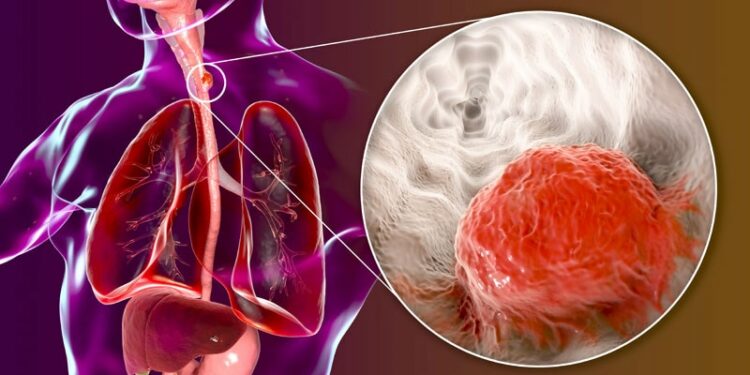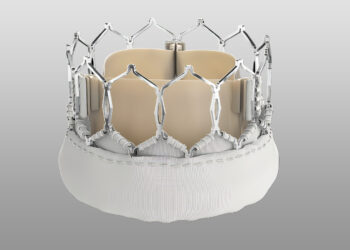[ad_1]
A novel treatment approach combining neoadjuvant immunotherapy with chemoradiation showed promising results in patients with locally advanced esophageal squamous cell carcinoma (ESCC), according to preliminary findings from the phase 3 SCIENCE trial.
Lead investigator Xuefeng Leng, MD, PhD, of Sichuan Cancer Hospital, Chengdu, China, presented these results at the ASCO Gastrointestinal Cancers Symposium 2025 in San Francisco.

The multicenter study showed that addition of the programmed cell death protein 1 (PD-1) inhibitor sintilimab to neoadjuvant chemoradiotherapy achieved a pathological complete response (pCR) rate of 60% compared with 47.3% with chemoradiotherapy alone in patients with resectable locally advanced ESCC, without increasing surgical risks.
“While neoadjuvant chemoradiotherapy or chemotherapy is standard treatment for locally advanced ESCC, the optimal neoadjuvant treatment strategy remains uncertain in the immunotherapy era,” said Leng, during his presentation. “Our findings suggest that adding sintilimab to neoadjuvant chemoradiotherapy may improve pathological complete response outcomes without increasing surgical risks, and this regimen has the potential to become the new standard of care in the near future.”
Study Design and Patient Population
The SCIENCE trial (NCT05244798) enrolled 146 patients between November 2022 and June 2024 across four high-volume centers in China. Eligible patients had previously untreated, resectable, locally advanced thoracic ESCC staged as cT1N2-3M0 or cT2-4aN0-3M0.
Participants were randomized 1:1:1 to receive one of three neoadjuvant treatment regimens: Two cycles of sintilimab plus chemotherapy (nab-paclitaxel and carboplatin) in group A, sintilimab plus concurrent chemoradiotherapy (nab-paclitaxel and carboplatin given together with 41.4 Gy radiation) in group B, and concurrent chemoradiotherapy alone (nab-paclitaxel and carboplatin given together with 41.4 Gy radiation, without sintilimab) in group C. All patients underwent surgery 6-8 weeks after completing their assigned neoadjuvant treatment regimen.
In an interview Leng explained the rationale for using sintilimab among other immune checkpoint inhibitors: “[It was] chosen for its well-recognized efficacy and safety profile, widely used in multiple cancer treatments. The ORIENT-15 trial demonstrated good efficacy in first-line advanced ESCC treatment, regardless of PD-L1 [PD ligand 1] expression status, leading to its approval in 2022 in China.”
The characteristics of the study population were well balanced across the groups, with predominantly male patients (89.7%) and patients with clinical stage III disease (72.6%). Most tumors were located in the middle thoracic esophagus (51.4%).
Addressing the study population characteristics, Leng emphasized in the interview that “these demographics are highly representative of the ESCC patient population seen in clinical practice, particularly in regions like East Asia and China where the disease is prevalent.” He added that male predominance reflects known epidemiological patterns, likely related to risk factors such as smoking and alcohol use.
Addition of Sintilimab to Neoadjuvant Chemoradiotherapy Improves Response Rates
The preliminary analysis, triggered at approximately one third of planned enrollment, focused on pCR rates, which was the primary endpoint. The pCR rates were 13% with sintilimab plus chemotherapy (group A), 60% with sintilimab plus chemoradiotherapy (group B), and 47.3% with chemoradiotherapy alone (group C).
The difference in pCR between group B and group A was particularly notable at 47% (95% CI, 27.8-62.2; odds ratio [OR], 10.0; 95% CI, 3.7-30.8; P P = .0005).
When asked about the particularly high efficacy of the combination therapy, Leng explained in an interview: “The combination of chemoradiotherapy plus sintilimab likely achieves higher pCR rates due to its synergistic effects. Radiotherapy not only directly targets tumor cells but also enhances immune activation by releasing tumor antigens, which complements the immune checkpoint inhibition of sintilimab. Chemotherapy further reduces the tumor burden and modulates the tumor microenvironment to increase immunogenicity.”
Surgical Outcomes and Safety
All patients completed neoadjuvant treatment and proceeded to surgical resection, achieving a 100% R0 resection rate. Leng emphasized that most patients underwent minimally invasive procedures, including thoracoscopic and robot-assisted McKeown procedures. “Surgical complications were well controlled at these high-volume centers, with anastomotic leak rates remaining low across all arms,” Leng reported.
In an interview, Leng explained that the 4-8 week window between completion of neoadjuvant therapy and surgery allowed adequate tumor regression while minimizing fibrotic changes that could complicate resection. “The use of minimally invasive esophagectomy with systematic lymph node dissection by experienced surgeons ensured precise tumor removal and optimal lymph node clearance,” he said.
Treatment-emergent adverse events (TEAEs) showed varying patterns across the groups. Any-grade TEAEs were reported in 50% of patients in group A, 86.7% in group B, and 85.5% in group C. The rate of grade ≥ 3 TEAEs was the highest in group C (36.4%), followed by group B (31.1%) and group A (8.7%).
Leng highlighted an interesting finding regarding specific toxicities: “Group B, combining chemoradiotherapy with immunotherapy, showed lower rates of lymphopenia, leukopenia, and neutropenia compared to chemoradiotherapy alone.”
Looking at the Bigger Picture
In a discussion following the presentation, Harry H. Yoon, MD, MHS, of Mayo Clinic, Rochester, Minnesota, provided context for interpreting these results within the broader landscape of neoadjuvant immunotherapy in ESCC.
“The preliminary findings of the SCIENCE study suggest that addition of sintilimab to neoadjuvant chemoradiation improves the pathological complete response rate in resectable esophageal squamous cancer,” Yoon noted. “This promising result builds on prior data suggesting that immunotherapy improves pathological complete response in nonmetastatic ESCC.”
Yoon compared the SCIENCE trial results with those of two similar studies.
“The ESCORT-NEO study examining camrelizumab with chemotherapy showed that adding immunotherapy improved pCR rates, particularly with nab-paclitaxel, improving pCR by 23%,” he explained. “The Henan Cancer Hospital study demonstrated a 14% improvement in pCR with toripalimab plus chemotherapy, though it did not meet its prespecified threshold for survival benefit.”
However, Yoon emphasized the need for caution when interpreting the findings of these studies.
“It remains unclear to what degree an improved pCR rate translates to improved patient survival. The survival data from SCIENCE have not yet been reported.”
Although these findings contribute to the growing evidence supporting immunotherapy integration into multimodal treatment approaches for resectable ESCC, mature survival data will be crucial for determining the ultimate clinical impact of this strategy, Yoon said.
Looking ahead, Leng expressed optimism about the potential long-term impact: “Given the strong correlation between pCR and long-term survival in ESCC, we anticipate that the higher pCR rates observed with chemoradiotherapy plus sintilimab will translate into improved event-free and overall survival,” he noted in an interview. However, he cautioned that “the preliminary results of this report, which is the first interim results report, may be subject to new data changes as the number of enrolled cases increases.”
The SCIENCE study continues to enroll patients, with event-free survival data still being monitored. As Leng concluded, “If these outcomes are confirmed, this regimen could become a standard option for fit patients with locally advanced ESCC. Future treatment selection may increasingly prioritize regimens that maximize pCR rates, with ongoing efforts to identify biomarkers that predict response and guide personalized therapy.”
The study was independently supported. Leng reported no relevant financial relationships. Yoon reported receiving consulting or advisory fees from Amgen, Astellas Scientific and Medical Affairs Inc., AstraZeneca, BeiGene, Bristol Myers Squibb, Elevation Oncology, Merck, Novartis, and Zymeworks; research funding from BeiGene, Bristol Myers Squibb Foundation, CARsgen Therapeutics, and Merck; and travel or accommodation expenses from BeiGene.
Christos Evangelou, PhD, is a freelance medical writer and science communications consultant.
[ad_2]
Source link : https://www.medscape.com/viewarticle/adding-pd-1-inhibitor-chemoradiation-boosts-complete-2025a10001xz?src=rss
Author :
Publish date : 2025-01-27 10:08:06
Copyright for syndicated content belongs to the linked Source.














